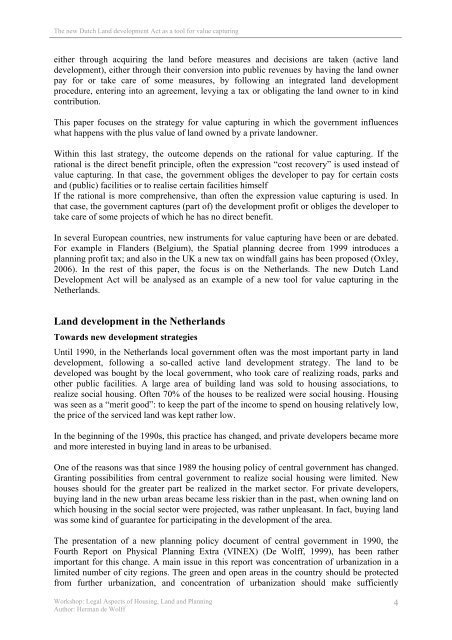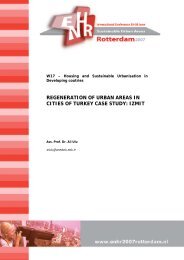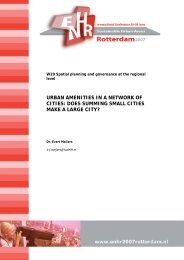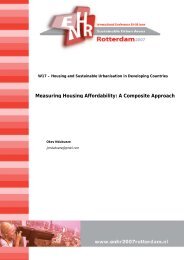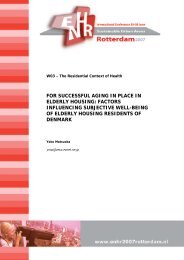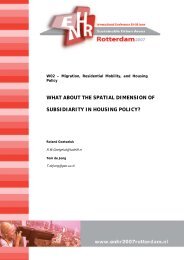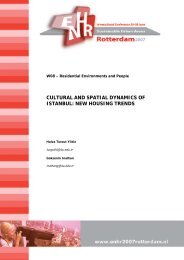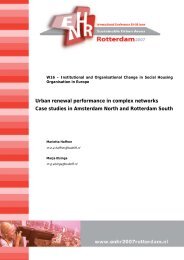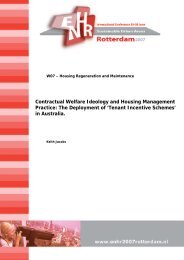The new Dutch Land development Act as a tool for value capturing
The new Dutch Land development Act as a tool for value capturing
The new Dutch Land development Act as a tool for value capturing
Create successful ePaper yourself
Turn your PDF publications into a flip-book with our unique Google optimized e-Paper software.
<strong>The</strong> <strong>new</strong> <strong>Dutch</strong> <strong>Land</strong> <strong>development</strong> <strong>Act</strong> <strong>as</strong> a <strong>tool</strong> <strong>for</strong> <strong>value</strong> <strong>capturing</strong><br />
either through acquiring the land be<strong>for</strong>e me<strong>as</strong>ures and decisions are taken (active land<br />
<strong>development</strong>), either through their conversion into public revenues by having the land owner<br />
pay <strong>for</strong> or take care of some me<strong>as</strong>ures, by following an integrated land <strong>development</strong><br />
procedure, entering into an agreement, levying a tax or obligating the land owner to in kind<br />
contribution.<br />
This paper focuses on the strategy <strong>for</strong> <strong>value</strong> <strong>capturing</strong> in which the government influences<br />
what happens with the plus <strong>value</strong> of land owned by a private landowner.<br />
Within this l<strong>as</strong>t strategy, the outcome depends on the rational <strong>for</strong> <strong>value</strong> <strong>capturing</strong>. If the<br />
rational is the direct benefit principle, often the expression “cost recovery” is used instead of<br />
<strong>value</strong> <strong>capturing</strong>. In that c<strong>as</strong>e, the government obliges the developer to pay <strong>for</strong> certain costs<br />
and (public) facilities or to realise certain facilities himself<br />
If the rational is more comprehensive, than often the expression <strong>value</strong> <strong>capturing</strong> is used. In<br />
that c<strong>as</strong>e, the government captures (part of) the <strong>development</strong> profit or obliges the developer to<br />
take care of some projects of which he h<strong>as</strong> no direct benefit.<br />
In several European countries, <strong>new</strong> instruments <strong>for</strong> <strong>value</strong> <strong>capturing</strong> have been or are debated.<br />
For example in Flanders (Belgium), the Spatial planning decree from 1999 introduces a<br />
planning profit tax; and also in the UK a <strong>new</strong> tax on windfall gains h<strong>as</strong> been proposed (Oxley,<br />
2006). In the rest of this paper, the focus is on the Netherlands. <strong>The</strong> <strong>new</strong> <strong>Dutch</strong> <strong>Land</strong><br />
Development <strong>Act</strong> will be analysed <strong>as</strong> an example of a <strong>new</strong> <strong>tool</strong> <strong>for</strong> <strong>value</strong> <strong>capturing</strong> in the<br />
Netherlands.<br />
<strong>Land</strong> <strong>development</strong> in the Netherlands<br />
Towards <strong>new</strong> <strong>development</strong> strategies<br />
Until 1990, in the Netherlands local government often w<strong>as</strong> the most important party in land<br />
<strong>development</strong>, following a so-called active land <strong>development</strong> strategy. <strong>The</strong> land to be<br />
developed w<strong>as</strong> bought by the local government, who took care of realizing roads, parks and<br />
other public facilities. A large area of building land w<strong>as</strong> sold to housing <strong>as</strong>sociations, to<br />
realize social housing. Often 70% of the houses to be realized were social housing. Housing<br />
w<strong>as</strong> seen <strong>as</strong> a “merit good”: to keep the part of the income to spend on housing relatively low,<br />
the price of the serviced land w<strong>as</strong> kept rather low.<br />
In the beginning of the 1990s, this practice h<strong>as</strong> changed, and private developers became more<br />
and more interested in buying land in are<strong>as</strong> to be urbanised.<br />
One of the re<strong>as</strong>ons w<strong>as</strong> that since 1989 the housing policy of central government h<strong>as</strong> changed.<br />
Granting possibilities from central government to realize social housing were limited. New<br />
houses should <strong>for</strong> the greater part be realized in the market sector. For private developers,<br />
buying land in the <strong>new</strong> urban are<strong>as</strong> became less riskier than in the p<strong>as</strong>t, when owning land on<br />
which housing in the social sector were projected, w<strong>as</strong> rather unple<strong>as</strong>ant. In fact, buying land<br />
w<strong>as</strong> some kind of guarantee <strong>for</strong> participating in the <strong>development</strong> of the area.<br />
<strong>The</strong> presentation of a <strong>new</strong> planning policy document of central government in 1990, the<br />
Fourth Report on Physical Planning Extra (VINEX) (De Wolff, 1999), h<strong>as</strong> been rather<br />
important <strong>for</strong> this change. A main issue in this report w<strong>as</strong> concentration of urbanization in a<br />
limited number of city regions. <strong>The</strong> green and open are<strong>as</strong> in the country should be protected<br />
from further urbanization, and concentration of urbanization should make sufficiently<br />
Workshop: Legal Aspects of Housing, <strong>Land</strong> and Planning<br />
Author: Herman de Wolff<br />
4


